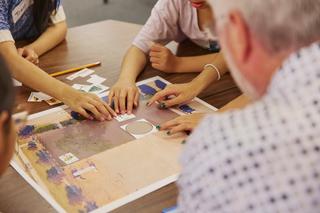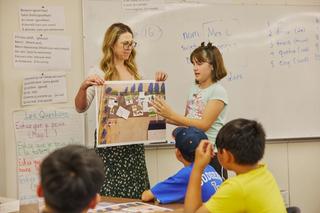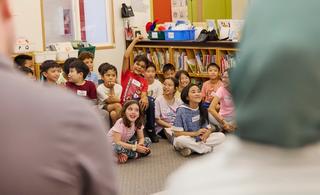Last week, thirty Sir Wilfred Grenfell Elementary School students gathered for the very first Nature Park design session, officially launching BC Parks Foundation’s ambitious new initiative to transform schoolyards across BC into vibrant nature-filled learning spaces. This inaugural cohort spent the afternoon co-creating their dream schoolyard alongside the Vancouver School Board, City of Vancouver, BC Parks Foundation and ISL Engineering.
The ideas came fast and loud as they rushed into the library of their swing-site school and began imagining their future schoolyard.
With their school currently under repair—they'll be at the swing-site for the rest of the school year—the importance of where they learn has never been more apparent.
And, when they return to their school in 2026, the Nature Park they helped design will be there to welcome them.
“This is the roadmap to a new future for BC schoolyards,” said Laura Hergott, Manager of Education at BC Parks Foundation. “Today’s session shows us what’s possible when students lead the way. The only thing that would have made it better is if we were outside, and that’s exactly what this program is about: creating spaces where this kind of learning can happen under a canopy of trees.”
Sorting through 24 potential Nature Park features—from butterfly meadows to rain gardens—the students debated, compromised, and collaborated until they landed on a shared vision for their Nature Park.

“Without any prompting from us, they were zoning ecosystems, thinking about safety, sustainability, and water use—like professional designers,” said Andrew from ISL. “They gave us ideas we didn’t have before, and that’s going to directly shape what gets built.”
Their designs prioritized recycled water for fountains, natural materials over plastic, and safety, keeping insect hotels away from the playground.
One group even adjusted placement to ensure supervision aids could monitor a future pond without adding a fence that would “ruin the vibe.”
Julie McManus, Green Infrastructure Project Manager for the City of Vancouver, highlighted the significance of this project beyond the schoolyard. “Grenfell School sits on the Still Creek watershed, which connects to one of our most important ecological corridors,” she said. “This Nature Park will helpsoak uprainwater, boost biodiversity, and build a greener, more climate-resilient city. And the students designing it are the future leaders who will carry that work forward.”
Grenfell teacher Holly Lee said the day perfectly linked classroom learning with real-world impact. “The students brought their knowledge of pollinators, gardening, and ecosystems into today’s design process. Their creativity and care for nature made me so proud.”

When the work was done, the students stood in front of their peers, proudly presenting their maps: “We didn’t put the insect hotel next to the birdhouse so the birds won’t eat the insects.”
“We put shelter near the wildflower garden so we can enjoy it even in the rain.”
“Fruit trees go near the rain garden, so they stay watered.”
When asked what excited students most about returning to their school to their Nature Park in 2026, their answers were immediate:
“We get to create our own space. We get to choose.”
“I focus better outside.”
“I am calmer outside.”
“It’s quieter, more peaceful. We designed shelters so we can even learn outside in the rain. The fresh air is helpful.”
In other words, the students already know what science tells us—that learning in nature is good for the brain, body, and spirit.
And today, they got to contribute to designing the space where they will do exactly that.
